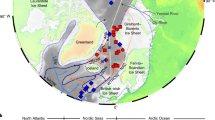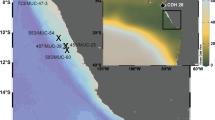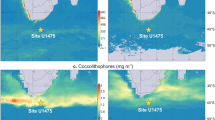Abstract
Convection to 2,000 m in the Labrador Sea during severe winters partially renews Labrador Sea Water (LSW)1, a water mass trace-able at intermediate depth throughout the north Atlantic Ocean (north of 40° N)2 and along the western boundary to the Equator3. Anthropogenic chlorofluoromethanes (CFMs) have been used3 to estimate the transit time of LSW from its source region to the Equator, together with its degree of dilution by 'older' waters. CFMs may also be used to constrain 'diagnostic' ocean circulation models4. Such applications depend critically on the concentration and the rate of change of CFMs in newly formed LSW. Here we report the first Labrador Sea CFM data, including measurements from a > 1,500 m deep column of recently renewed water, that suggest that LSW originated at only 60% saturation with respect to contemporary atmospheric concentrations, in contrast to the 100% usually assumed in interpretations of tracer distributions away from source regions. The newly formed water mass was also colder and less saline than any previously measured LSW. Monitoring of CFMs and other tracers in this region will be essential for establishing boundary conditions for models of the North Atlantic tracer distributions.
This is a preview of subscription content, access via your institution
Access options
Subscribe to this journal
Receive 51 print issues and online access
$199.00 per year
only $3.90 per issue
Buy this article
- Purchase on Springer Link
- Instant access to full article PDF
Prices may be subject to local taxes which are calculated during checkout
Similar content being viewed by others
References
Clarke, R. A. & Gascard, J.-C. J. phys. Oceanogr. 13, 1764–1778.
Talley, L. D. & McCartney, M. S. J. phys. Oceanogr. 12, 1189–1205 (1982).
Weiss, R. F., Bullister, J. L., Gammon, R. H. & Warner, M. J. Nature 314, 608–610 (1985).
Woods, J. D. Nature 314, 501–511 (1985).
Lazier, J. R. N. Atmos.-Ocean 18, 227–238 (1981).
Clarke, R. A. & Coote, A. R. J. phys. Oceanogr. (in the press).
Gascard, J.-C. & Clarke, R. A. J. phys. Oceanogr. 13, 1779–1797 (1983).
Gordon, A. L. J. phys. Oceanogr. 8, 600–612 (1978).
Roether, W. in Dynamic Processes in the Chemistry of the Upper Ocean (eds Burton, J. D., Brewer, P. G. & Chesselet, R.) 117–128 (Plenum, New York, 1986).
Warner, M. J. & Weiss, R. F. Deep Sea Res. 32, 1485–1497 (1985).
Smith, S. D. & Dobson, F. W. Atmos.-Ocean 22, 1–22 (1984).
Shuhy, J. L. Oceanographic Report No. CG373-78, Oceanographic Observations North Atlantic Ocean Station Bravo, Terminal Report 1964-1974 (US Coast Guard Oceanography Unit, Washington DC, 1978).
Wallace, D. W. R. & Moore, R. M. J. geophys. Res. 90, 1155–1166 (1985).
Author information
Authors and Affiliations
Rights and permissions
About this article
Cite this article
Wallace, D., Lazier, J. Anthropogenic chlorofluoromethanes in newly formed Labrador Sea Water. Nature 332, 61–63 (1988). https://doi.org/10.1038/332061a0
Received:
Accepted:
Issue Date:
DOI: https://doi.org/10.1038/332061a0
This article is cited by
-
Surprisingly rapid spreading of newly formed intermediate waters across the North Atlantic Ocean
Nature (1997)
-
Chlorofluorocarbon evidence for recent ventilation of the deep Bering Sea
Nature (1995)
-
Cooling and freshening of the subpolar North Atlantic Ocean since the 1960s
Nature (1992)
-
Large air–sea gas fluxes associated with breaking waves
Nature (1992)
Comments
By submitting a comment you agree to abide by our Terms and Community Guidelines. If you find something abusive or that does not comply with our terms or guidelines please flag it as inappropriate.



